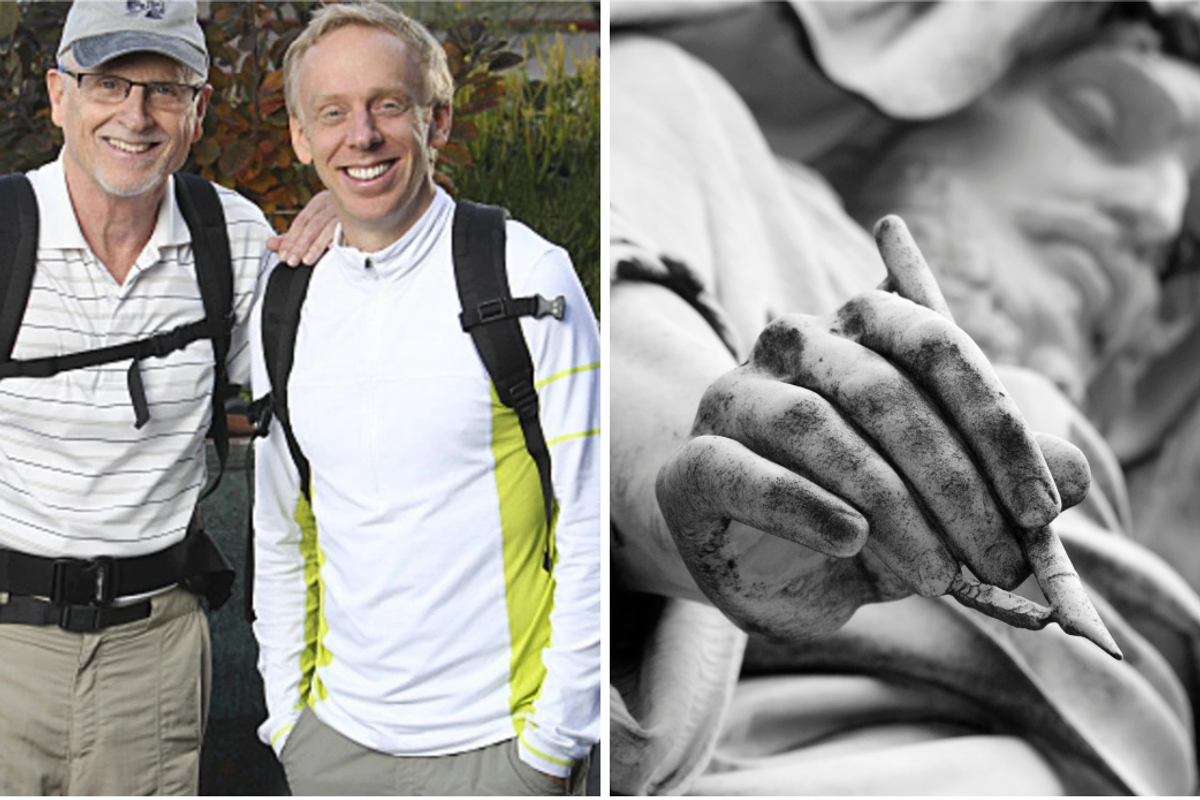White Lotus creator Mike White reveals his gay father’s wild past with Christian televangelists
You've never heard a coming out story quite like this.

During a recent podcast, White revealed an intriguing piece of family history.
Even by Hollywood standards, Mike White is quite the character. Born Michael Christopher White, the award-winning actor, producer, director, and screenwriter has been active in the industry for over 25 years. He's penned screenplays for films like School of Rock and Nacho Libre, while also writing and producing shows including Dawson's Creek and Freaks and Geeks.
He's proven to be a reality TV savant, too—White reached second place on Survivor: David vs. Goliath and competed twice on The Amazing Race (season 14 and The Amazing Race: Unfinished Business) alongside his father, Mel. But if you’ve heard anything about Mike White lately, it’s likely due to the gargantuan success of his HBO Max series, The White Lotus, which has earned him three Primetime Emmy Awards and is now in its third season. During a recent appearance on Andrew Sullivan's The Dishcast podcast, White revealed an intriguing piece of family history. Before becoming an LGBTQ+ activist, his father, Mel, was a prominent ghostwriter for America's televangelist movement.
“He wanted to be the next Billy Graham.”
For 25 years, James Melville "Mel" White was a "pillar" of the evangelical community. He lived in Pasadena, CA with Lyla, his wife and childhood sweetheart, and their two children. He held a master's degree in divinity and a doctorate in ministry, then later led his own church, Pasadena Covenant. Mel White taught at Fuller Theological Seminary, the largest nondenominational evangelical school in the country.

According to a 1993 profile by the Los Angeles Times, White had become an accomplished author and documentarian. His inspirational books sold millions of copies, and he produced over 50 Christian-themed film documentaries that were shown throughout the country.
But beneath this thriving public life, he carried a profound secret: he was gay.
“I found out around middle school, when I was maybe 10 or 11 years old,” recounts Mike on The Dishcast. “It wasn’t like, ‘I’m gay, hello!’” he adds. “It was not on his agenda to be gay; it was a very long, drawn-out process. It was probably the worst time in my life.”
During this period, another shocking twist was unveiled: throughout the late 70s and 80s, while Reverend Mel White privately struggled with his sexuality (in his bestselling autobiography, Stranger at the Gate: To Be Gay and Christian in America, Mel describes enduring two decades of counseling, exorcisms, and electric shock therapy due to the church's condemnation of homosexuality—an ordeal so taxing, it led him to attempt suicide), he paradoxically became the most sought-after ghostwriter among the televangelist movement's elite. By the time he came out as gay in the early 90s, Mel White had penned books including Jerry Falwell's 1987 autobiography, Strength for the Journey, Pat Robertson's America's Dates With Destiny, and Billy Graham's Approaching Hoofbeats: The Four Horsemen of the Apocalypse. These weren't just well-known religious figures—they were televangelism's superstars.
Flooded with work, yet grappling with the weight of his suppressed sexuality, Mel White found himself between a rock and a hard place. Should he come out and live his best, true life? Or, could he force himself to ride this cash cow—in silence—for just a little bit longer? He chose the latter. “[Ghostwriting books for televangelists] was lucrative because his books were given away. Like, if you donated something to the church, you would get his book, so there was a built-in royalty factor,” says Mike White. “My dad actually made pretty good money doing that and got me through private school and college.” He adds, “My parents separated, but because all of his income came from these books—and he couldn’t have been an out, gay man and remained associated with these people—he stayed closeted until my sister and I got through college.” On a personal level, Mel White was put through hell and was living in a world of chaos. But professionally, he’d never been more successful. “I can say I did it to put my kids through college, to pay the bills for my wife and family,” he said in 1993. “I can say I did it because it was fun, traveling around the world on private jets, staying in nice places.” And he was well-compensated for his work: for Jerry Falwell’s autobiography, he was paid $125,000 for about five months of work, the equivalent of $547,719 today.
Communicating Christ’s message through TV
Starting in the 1960s, evangelicals began to dominate the airwaves. While other religions were wary of television, a relatively new technology, or couldn’t afford to purchase airtime, evangelicals, on the other hand, saw TV as the perfect conduit for getting in touch with the masses. They happily dedicated large portions of their shows to raising money from listeners. In a way, televangelism (a portmanteau between “television” and “evangelism”) was a product of its time: an American phenomenon, found at the crossroads between freshly deregulated mass media and a large Christian population with even larger pockets.

In 1961, Pat Robertson founded the Christian Broadcasting Network (CBN) and launched its flagship show, The 700 Club, a few years later. Part talk show, part news reporting, Robertson paved the way for a generation of televangelists to follow. Jerry Falwell rose to prominence in the 1980s, “instantly” becoming a celebrity on TV, while fellow evangelists Paul Crouch and Jim Bakker followed with their own networks soon after.
According to Jeffrey K. Hadden, a professor of sociology at the University of Virginia at Charlottesville, between the late 1960s and the mid-80s, the number of Americans watching religious TV ballooned from 5 million to 25 million. Not only was televangelism growing at a rapid rate, but so was its influence. Soon, the movement began to dip its toes into the political sphere, culminating in Falwell’s Moral Majority coalition endorsing Ronald Reagan in his 1980 presidential election bid.
However, the aggressive tactics and harmful rhetoric employed by televangelism began to rub people the wrong way. In 1990, Steve Bruce, a professor of sociology at the University of Aberdeen, wrote:
“In a country more committed than most to the extension of individual freedom, televangelists have been some of the most vocal proponents of tradition social taboos, notably in their campaigns against the right of women to an abortion and towards greater public tolerance of homosexual relationships. And in a society where any intervention of religion into politics is treated with almost unnatural suspicion, televangelists have, in the last decade especially, made themselves notorious in their open advocacy of conservative Republican candidates… both for national and local office.”
He continues, “It is that sense of influence beyond its naturally eccentric—minority—constituency, which has recently transformed televangelism in the minds of some observers… from being little more than an elaborate joke…into being a real and present danger in the life of liberal democracy and for the survival of civilized values.”
From ghostwriter to LGBTQ+ activist
Once Mike White and his sister finished college, his father, Mel, left the Christian church, dumped televangelism, and became a proud spokesperson for LGBTQ+ rights. “He’s standing with the gay rights activists and shouting back at the biggest names in American televangelism—‘homophobic hatemongers,’ he calls them—whose lucre he pocketed for years,” describes the Washington Post in 1993. He wrote about his journey and the televangelist movement in books like Stranger at the Gate and Religion Gone Bad: Hidden Dangers from the Christian Right.

After leaving his church in Pasadena, Mel White was appointed as “dean” of Dallas’ Cathedral of Hope, the largest gay church in the world and the flagship institution of the 30,000-member national gay denomination known as the Metropolitan Community Church (MCC).
“His gay activism was specifically targeted towards trying to convince the Religious Right and those that he had worked for prior,” remembers Mike White. He wanted to rewrite the church’s narrative about being gay, which, at the time, told its constituents that there would be “life or death” consequences for same-sex attraction. “He would go around the country, to religious colleges with gay students,” Mike continues. “He’d have them try to bear witness to the harm that was being caused by religion-based oppression or hate.” That work led to the creation of Soulforce, a gay advocacy group co-founded by Mel White and his husband, Gary Nixon. In 1997, White received the American Civil Rights Union’s National Civil Liberties Award for his principles of relentless nonviolent resistance, which he applied to the “struggle for justice for sexual minorities.”
Although his upbringing was challenging, Mel's work and legacy are clearly important to his son, Mike White. In 2022, the then-52-year-old gave an emotional speech while accepting the Primetime Emmy Award for best director for The White Lotus. "I wanna thank my parents, I love my parents, my mom let me be the weird kid I wanted to be, and my dad, who's struggling right now," White said of Mel, 82. "Thank you so much for letting me honor him tonight.” That speech is a testament to the power of authenticity, a theme that’s woven into every fiber of his father’s story. You are who you are—and that’s enough.
Check out the full episode of The Dishcast here.


 These matching bunny ears though.
These matching bunny ears though.  Many adult twins regret that their names are so closely linked together.
Many adult twins regret that their names are so closely linked together.  'Kill shelters' are really just open-intake shelters, which means they don't turn any animal away.
'Kill shelters' are really just open-intake shelters, which means they don't turn any animal away. Animal shelters can easily become overpopulated.
Animal shelters can easily become overpopulated. Stray animal overpopulation is a big problem in places all over the U.S.
Stray animal overpopulation is a big problem in places all over the U.S. Both "kill" and "no kill" shelters need support.
Both "kill" and "no kill" shelters need support. Animal rescues try to home as many animals as they can, but demand is greater than supply in many places.
Animal rescues try to home as many animals as they can, but demand is greater than supply in many places. Beaver in water. Photo by
Beaver in water. Photo by  An actual beaver dam on the now-thriving Price River
An actual beaver dam on the now-thriving Price River